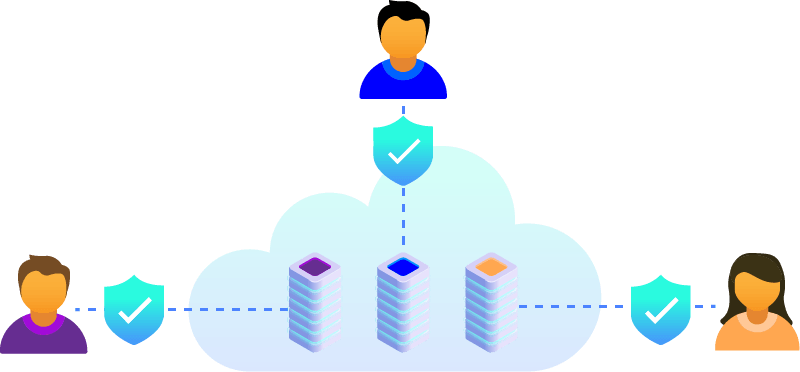PUBLIC CLOUD SECURITY VS PRIVATE CLOUD SECURITY
It’s pretty remarkable how much the use and advancement of the cloud has changed the way enterprises – and their employees – operate. From enabling globetrotting salesmen to log in to company databases to accessing documents on a smartphone, cloud computing has transformed IT and the possibilities continue to grow. With the benefits on offer it can be easy to believe that no drawbacks exist but when it comes to the cloud security remains a crucial consideration.
While opportunities abound with cloud, there are challenges and pitfalls, as well as different methods to achieve your desired results. Should businesses go with a public cloud, or opt for a private cloud housed on company property? Is the best option a hybrid mixture of public and private cloud use? In this guide, we consider both public cloud security and private cloud security to evaluate the pros and cons of both.
All types of cloud services are on the rise. Data shows the use of public clouds is increasing, but private clouds still carry the majority of workloads. According to a recent study by Cisco, by 2018 31 percent of the cloud workloads will be in public cloud data centers (up from 22 percent in 2013) and 69 percent will be in private cloud data centers (down from 78 percent in 2013).
One of the reasons public cloud environments are growing in popularity is because it requires no capital investment on behalf of the user. With a public cloud, businesses purchase server space from a third-party provider. The servers are multi-tenant cloud deployments, meaning other companies’ data may be stored on the same server as your company’s data. Many businesses use some form of public clouds, whether it’s for email (i.e. Gmail), sharing documents (i.e. DropBox) or hosting web servers.
Private clouds, on the other hand, are single-tenant solutions. A company owns and operates the servers, or leases dedicated servers from a datacenter. A private cloud’s hardware can be stored on-site at a company’s property, or housed in a datacenter. In strictly regulated industries, such as finance and healthcare, a private cloud is a compliance necessity.

Determining the best cloud solution for your business is not an easy matter. There are three main points of difference between the public and private cloud: access, security, and continuity. Let’s take a look.
HOW EFFECTIVE IS CLOUD SECURITY
There’s been quite a bit written about cloud security and there’s a good reason for it. Security in the cloud – whether in a public or private cloud scenario – is a business necessity. Cloud adoption is continuing at a rapid pace and for good reason.
In a public cloud scenario, elements of security are typically provided by the third-party cloud service providers. Depending on the industry and type of information stored in a public cloud, there may not be enough privacy and security policies in place. These shortfalls contribute to public cloud environments increasing the attack surface for potential hackers particularly with the use of sophisticated malware.
A private cloud offers the most control over security parameters because all security efforts are done in-house, or are outsourced to a managed security provider. The security tools available with a private cloud include greater levels of authentication, API-enabled proecction, additional layers of automation, and the potential for scalability if required.
There are options for businesses looking for increased security while taking advantage of flexible public cloud infrastructure, such as a cloud-based content delivery network. At CDNetworks, our cloud security solutions provide DDoS protection, security for web applications and websites, and allow for the secure transfer of information over the internet.
Our cloud-based global infrastructure also accelerates content delivery to your customers around the world, reducing security risks.
ACCESS CONTROL TO CLOUD INFRASTRUCTURE
One of the greatest advantages of the cloud is it makes organizational data accessible with an internet connection. That’s the end result but, as IT professionals know, there are many steps and considerations to get to that endpoint successfully.
In a traditional data storage model, companies would have a locked dedicated server room on-premises that was monitored and maintained by IT staff and if needed, security teams. To access data stored on the servers, employees would have to log in from a network computer.
When storing company data and communications, the question of who has access to that vital information has always been a concern.
With a public cloud, the IT staff will likely never see the physical servers that house the company’s data. In most cases, it’s difficult to know who will have access to your servers (and the data that’s on those servers) at the datacenter. In the public cloud model, companies pay for space and for what they use, and your company’s data could be stored on the same server as other companies. Firewalls and other cybersecurity measures are sometimes managed by the cloud service provider as well, which frees up IT staff from day to day management, but also leaves your company’s data at risk of a data breach if there’s a lapse in security procedures on the public cloud providers end or unidentified misconfigurations.

Access can be further restricted with a private cloud solution. A company’s physical servers may be housed in a data center, but the IT department is typically responsible for carrying out data security configurations and monitoring. Physical protections, such as a locked cage for your company’s servers, can also be implemented depending on the security controls in place.
CONTINUITY
As more and more mission-critical applications, services, and sensitive data is stored in the cloud, it becomes increasingly important to ensure your cloud solution is available 24/7.
Both public and private clouds promise always-on solutions, but what about in the event of a disaster or cyber attack? Does the cloud solution have a plan in place? Does your cloud solution have built-in redundancy or the ability to absorb large amounts of traffic in a DDoS attack?
Public clouds often have a large capacity, but the ability to expand on-demand largely depends on the service provider. Depending on the configuration and available space on private clouds, a disaster could put key business solutions and security services offline.
Private clouds have the ability to spread the workload over multiple servers but are limited by the amount of server space a company owns or operated.
A hybrid cloud solution – one that involves public and private clouds – could help diversify data storage, protecting assets in the event of a disaster or attack.
Pairing your company’s cloud with a CDN provides access to a global network of cloud-based technologies. CDNetworks has more than 140 points of presence (PoPs) across the world. If there is a natural disaster in one area of the world, there are other servers ready and waiting to pick up the traffic ensuring continuity of your website or web-based applications. A CDN can absorb excessive amounts of traffic – a sign of a DDoS attack – and our cloud security monitors this activity and alerts customers of the issue.
FINAL THOUGHTS ON PRIVATE AND PUBLIC CLOUD SECURITY
The cloud – public, private, and hybrid cloud environments – are here to stay. Making it work for your business is an ongoing challenge.
Choose your cloud business partners with care; your business will depend on the availability of your cloud, whether it’s key data or an application. The right solution for your business may not come from a single cloud provider and it will likely involve a network of partners across multi-cloud environments.
The very nature of the cloud is its ability to integrate with all areas of your business and a cloud solution reflects that. Security, performance, and availability are all areas to thoroughly consider in your cloud solution.